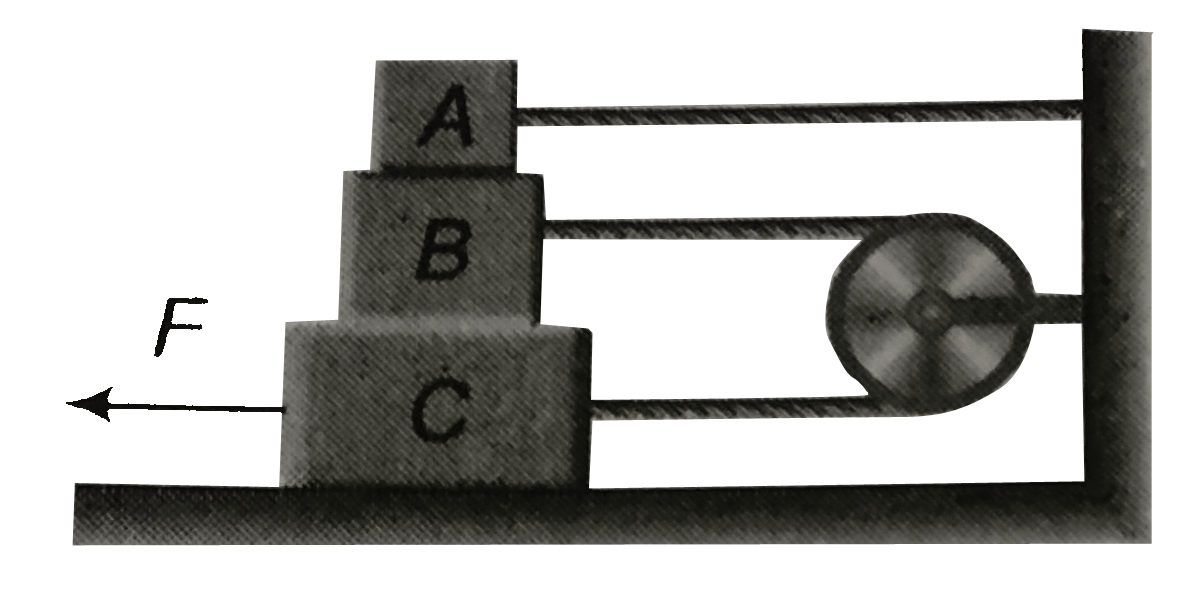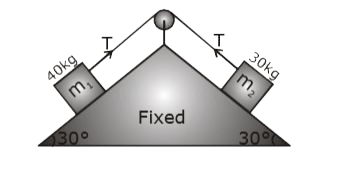In the diagram shown, the blocks A, B and C weight, 3kg, 4kg and 5kg respectively. The coefficient of sliding friction between any two surface is 0.25. A is held at rest by a massless rigid rod fixed to the wall while B and C are connected by a light flexible cord passing around a frictionless pulley. Find the force F necessary to drag C along the horizontal surface to the left at constant speed. Assume that the arrangement shown in the diagram, B on C and A on B, is maintained all through.

The correct Answer is:A
When force F is applied on C, the block C will move towards left.

F.B.D. for mass C is

As C is moving with constant speed …(i)
F.B.D. for mass B is

As B is moving with constant speed (ii)
Subtracting (ii) from (i)
Topper's Solved these Questions
- HEAT AND THERMODYNAMICSBOOK - SUNIL BATRA (41 YEARS IITJEE PHYSICS)CHAPTER - HEAT AND THERMODYNAMICSEXERCISE - JEE Main And Advanced
219 Videos
- MECHANICAL PROPERTIES OF MATTER AND FLUIDSBOOK - SUNIL BATRA (41 YEARS IITJEE PHYSICS)CHAPTER - MECHANICAL PROPERTIES OF MATTER AND FLUIDSEXERCISE - Subjective Problems
1 Videos
Similar Questions
Block A in figure-2.207 weights 2.7N and block B weighs 5.4 N the coefficient of kinetic friction between all surfaces is 0.25. Find the magnitude of the horizontal force F necessary to drag blocks to the left at constant speed if A and B are connected by a light, flexible cord passing around a fixed frictionless pulley

View SolutionBlock A as shown in figure weight 1.40N and block B weight 4.20N The coefficient of kinetic friction between all surface is 0.30 Find the magnitude of the horizontal force (in N) necessary to drag block B to the left at constant speed if A and B are connected by a light , flexible cord passing around a fixed , frictionless pulled.

View Solution
Knowledge Check
Block A as shown in Fig weighs 2.0N and block B weighs 6.0N The coefficient of ikinetic friction between all surface is 0.25 Find the magnitude of the horizontal force necessary to drag block B to the left at constant speed if A and B are connected by a light , flxeible cord passing around a fixed, frictionless pulley
 A2NB3NC5ND6N
A2NB3NC5ND6NMA=3kg,MB=4kg,MC=8kg. Coefficient of friction between any two surface is 0.25 pulley is frictionless and string is massless .A is connected to wall through a massless right rod.
 Avalue of F to keep C moving with constant speed is 80NBvalue of F to keep C moving with constant speed is 120NCif Fis200N then acceleration of B is 10m/s−2Dto slide C towards left ,F should be at least 50N (Take g=10m/s−2)
Avalue of F to keep C moving with constant speed is 80NBvalue of F to keep C moving with constant speed is 120NCif Fis200N then acceleration of B is 10m/s−2Dto slide C towards left ,F should be at least 50N (Take g=10m/s−2)Three blocks A , B and C of masses 4kg , 2kg and 1kg respectively are in contact on a frictionless surface, as shown. If a force of 14Nisappliedonthe4kgblock,thenthecontactforcebetweenAandB is.
 A2NB6NC8ND18N
A2NB6NC8ND18N
Three blocks A , B and C of masses 4kg , 2kg and 1kg respectively are in contact on a frictionless surface, as shown. If a force of 14Nisappliedonthe4kgblock,thenthecontactforcebetweenAandB is.

View SolutionThree blocks are placed as shown. The coefficient of friction between any two surfaces is also as given in the diagram. Find the acceleration of the 1kg block at the instant when a force of 50N is applied on 5kg block.

View SolutionTwo masses 40kg and 30 kg connected by a massless string passing over a frictionless light pulley as shown in the figure. The tension ( almost ) in the string will be : ( All surfaces are frictionless)

View SolutionOn the figure shown two blocks each of mass 2 kg are connected though a massless inextensible string, which posses over a frictionless pulley. The coefficient of friction between any two surface is μ=0.1. Find the acceleration of the blocks.

View SolutionTwo forces act on a 4.5 kg block resting on a frictionless surface as shown in the given figure. What is the magnitude of the horizontal acceleration of the block ?

View Solution
